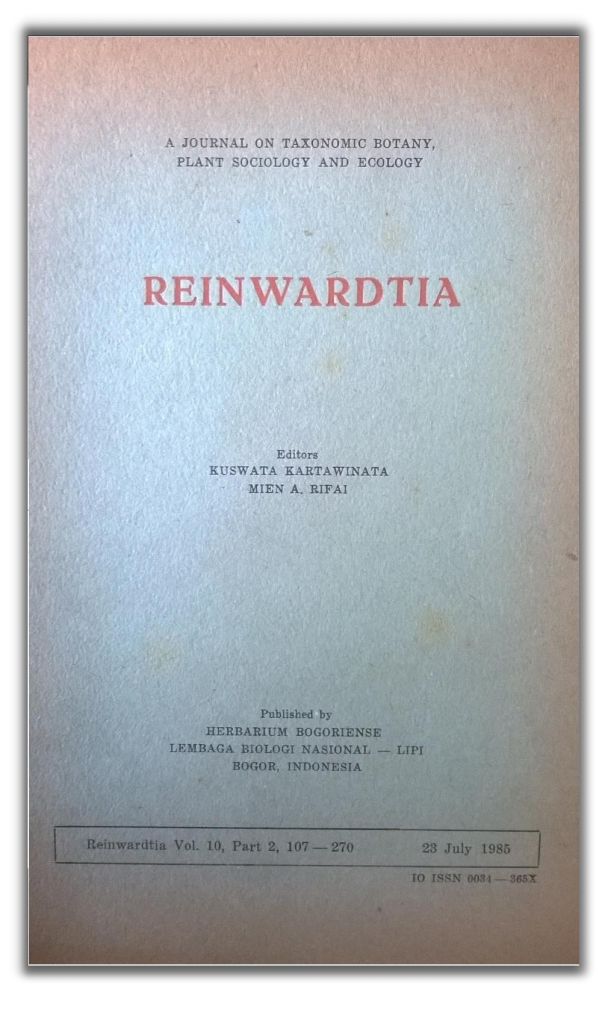PREDICTING HABITAT DISTRIBUTION OF ENDEMIC AND CRITICALLY ENDANGERED DIPTEROCARPUS LITTORALIS IN NUSAKAMBANGAN, INDONESIA
Main Article Content
Abstract
Article Details
References
ARAÚJO, M. B., PEARSON, R. G., THUILLER, W. & ERHARD, M. 2005. Validation of species–climate impact models under climate change. Glob. Change Biol.11: 1504-1513.
ASHTON, P. 1998. Dipterocarpus littoralis. The IUCN Red List of Threatened Species 1998: e.T33376A9773710. http://doi.org/10.2305/IUCN.UK.1998.RLTS.T33376A9773710.en. Accessed 29 August 2016
DCCC (Department of Environment & Climate Change). 2008. Littoral Rainforest in the South East Corner, Sydney Basin and NSW North Coast bioregions. http://www.environment.nsw.gov.au/ resources/threatenedspecies/EEClittoralrainforestlowres.pdf Accessed 29 August 2016.
DWIYANTI, F. G., HARADA, K., SIREGAR, I. Z. & KAMIYA, K. 2014. Population genetics of the critically endangered species Dipterocarpus littoralis Blume (Dipterocarpaceae) endemic on Nusakambangan Island, Indonesia. Biotropia 21: 1-12.
ELITH, J., GRAHAM, C. H., ANDERSON, R. P., DUDIK, M., FERRIER, S., GUISAN, A., HIJMANS, R. J., HUETTMANN, F., LEATHWICK, J. R., LEHMANN, A., LI, J., LOHMANN, L. G., LOISELLE, B. A., MANION, G., MORITZ, C., NAKAMURA, M., NAKAZAWA, Y., OVERTON, J. M. M., PETERSON, A. T., PHILLIPS, S. J., RICHARDSON, K., SCACHETTI-PEREIRA, R., SCHAPIRE, R. E., SOBERO´N, J., WILLIAMS, WISZ, S. M. & ZIMMERMANN, N. E. 2006. Novel methods improve prediction of species’ distributions from occurrence data. Ecography 29: 129-151.
GASTÓN, A. & GARCÍA-VIÑAS, J. I. 2011. Modelling species distributions with penalised logistic regressions: A comparison with maximum entropy models. Ecol. Model. 222: 2037-2041.
GU, Y., HUNT, E., WARDLOW, B., BASARA, J. B., BROWN, J. F. & VERDIN, J. P. 2008. Evaluation of MODIS NDVI and NDWI for vegetation drought monitoring using Oklahoma Mesonet soil moisture data. Geophys. Res. Lett. 35, L22401.
HAI, R., SHUGUANG, J., HONGXIAO, L., QIANMEI, Z., & HONGFANG, L. 2014. Advances in the reintroduction of rare and endangered wild plant species. Sci. China Life Sci. 57(6): 603-609.
HOLCIM. 2013. Kinerja Pengelolaan Lingkungan Juli 2012-Juni 2013. http://proper.menlh.go.id/portal/ filebox/DRKPL%202013%20HOLCIM%20CILACAP.pdf Accessed 27 June 2016.
ISLAM, M., SALIM, S. H., KAWSAR, M. H. & RAHMAN, M. 2016. The effect of soil moisture content and forest canopy openness on the regeneration of Dipterocarpus turbinatus CF Gaertn.(Dipterocarpaceae) in a protected forest area of Bangladesh. Trop. Ecol. 57: 455-464.
KREFT, H., JETZ, W., MUTKE, J., KIER, G. & BARTHLOTT, W. 2008. Global diversity of island floras from a macroecological perspective. Ecol. Lett. 11: 116-127.
LIU, C., WHITE, M. & NEWELL, G. 2013. Selecting thresholds for the prediction of species occurrence with presence?only data. J. Biogeogr. 40: 778-789.
MARINI, M. Â., BARBET-MASSIN, M., LOPES, L. E. & JIGUET, F. 2010. Predicting the occurrence of rare Brazilian birds with species distribution models. J. Ornithol. 151: 857-866.
MCHUGH, M.L. 2012. Interrater reliability: the kappa statistic. Biochem. Med. 22(3): 276-282.
MENARD, S. 2011. Standards for standardized logistic regression coefficients. Soc. Forces 89(4): 1409?1428.
PARTOMIHARDJO, T., ARIFIANI, D., PRATA-MA, B.A. & MAHYUNI, R. 2014. Jenis Jenis Pohon Penting di Hutan Nusakambangan. LIPI Press, Jakarta.
PEARSON, R. G. 2010. Species distribution modeling for conservation educators and practitioners. Lessons Conserv. 3: 54-89.
PHILLIPS, S. J. & DUDÍK, M. 2008. Modeling of species distributions with Maxent: new extensions and a comprehensive evaluation. Ecography 31: 161-175.
PRIMAJATI, M. 2015. Prediksi Kesesuaian Habitat Plahlar (Dipterocarpus littoralis) di Kawasan Cagar Alam Nusa Kambangan Barat. Flora Fauna Indonesia, Jakarta.
ROBIANSYAH, I. & DAVY, A. J. 2015. Population status and habitat preferences of critically endangered Dipterocarpus littoralis in West Nusakambangan, Indonesia. Makara J. Sci. 19: 150-160.
ROURA-PASCUAL, N., BROTONS, L., PETERSON, A. T. & THUILLER, W. 2009. Consensual predictions of potential distributional areas for invasive species: a case study of Argentine ants in the Iberian Peninsula. Biol. Invas. 11: 1017-1031.
SAHU, A.S. 2014. Identification and mapping of the water-logged areas in Purba Medinipur part of Keleghai river basin, India: RS and GIS methods. Int. J. Adv. Geosci. 2(2): 59-65.
SAX, D. F. & GAINES, S. D. 2008. Species invasions and extinction: The future of native biodiversity on islands. P. Natl. Acad. Sci. 105: 11490-11497.
SOBERÓN, J. 2007. Grinnellian and Eltonian niches and geographic distributions of species. Ecol. Lett. 10: 1115-1123.
THUILLER, W., LAVOREL, S. & ARAU´JO, M. B. 2005. Niche properties and geographical extent as predictors of species sensitivity to climate change. Glob. Ecol. Biogeogr. 14: 347-357.
TOGNELLI, M. F., ROIG-JUNENT, S. A., MARVALDI, A. E., FLORES, G. E. & LOBO, J. M. 2009. An evaluation of methods for modelling distribution of Patagonian insects. Rev. Chil. Hist. Nat. 82: 347-360.
USD. 2016. Bincang Plahlar di PSL USD. Humas Universitas Sanata Dharma. https://www.usd.ac.id/ deskripsi.php?idt=usd_berita&noid=2672 Accessed 27 June 2016.
WISZ, M. S., HIJMANS, R. J., LI, J., PETERSON, A. T., GRAHAM, C. H., GUISAN, A. & GROUP, N. P. S. D. W. 2008. Effects of sample size on the performance of species distribution models. Divers. Distrib. 14: 763-773.
YULITA, K. S. & PARTOMIHARDJO, T. 2011. Keragaman genetika populasi Pelahlar (Dipterocarpus littoralis (Bl.) Kurz) di Pulau Nusakambangan berdasarkan Profil Enhanced Random Amplified Polymorphic DNA. Berita Biologi 10: 541-548.

